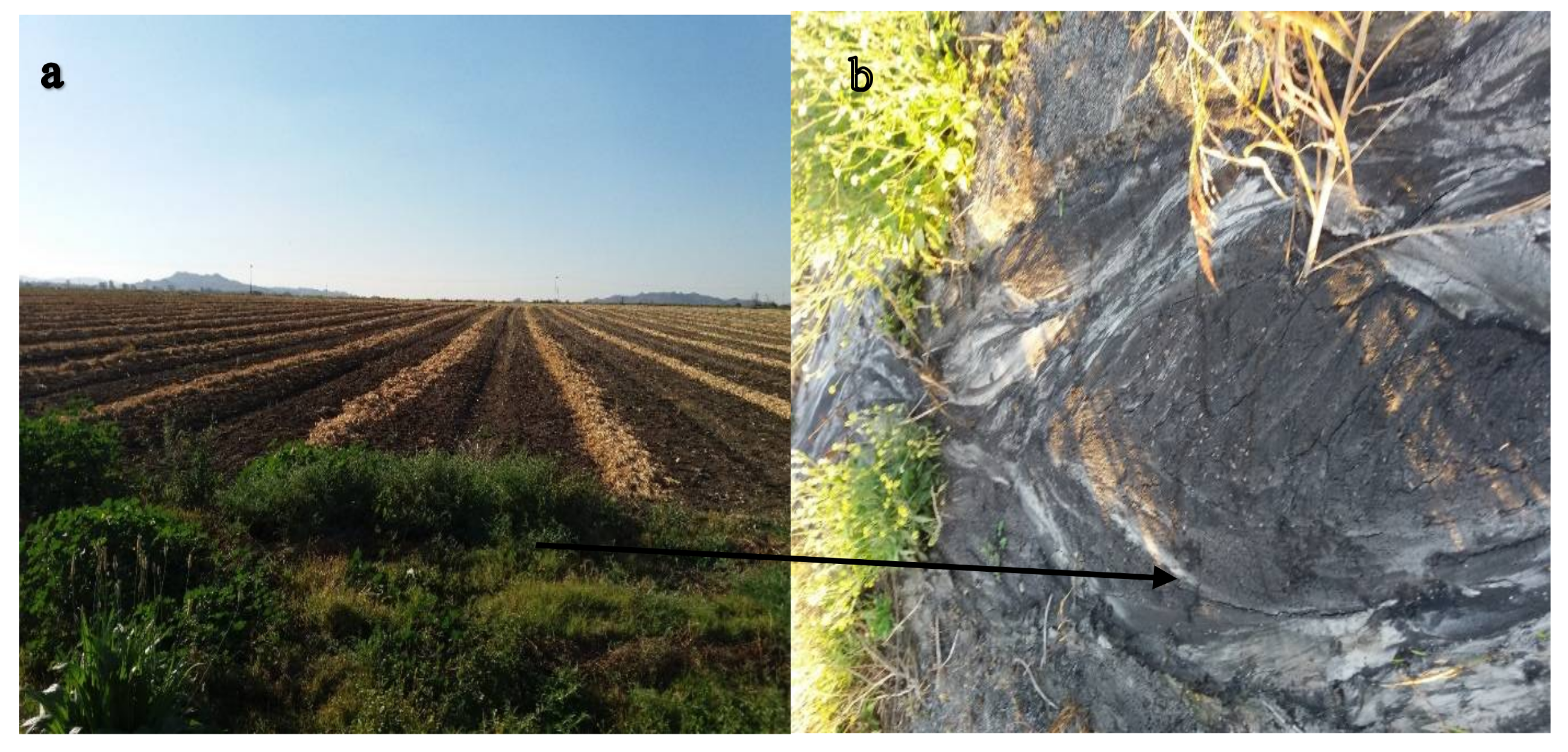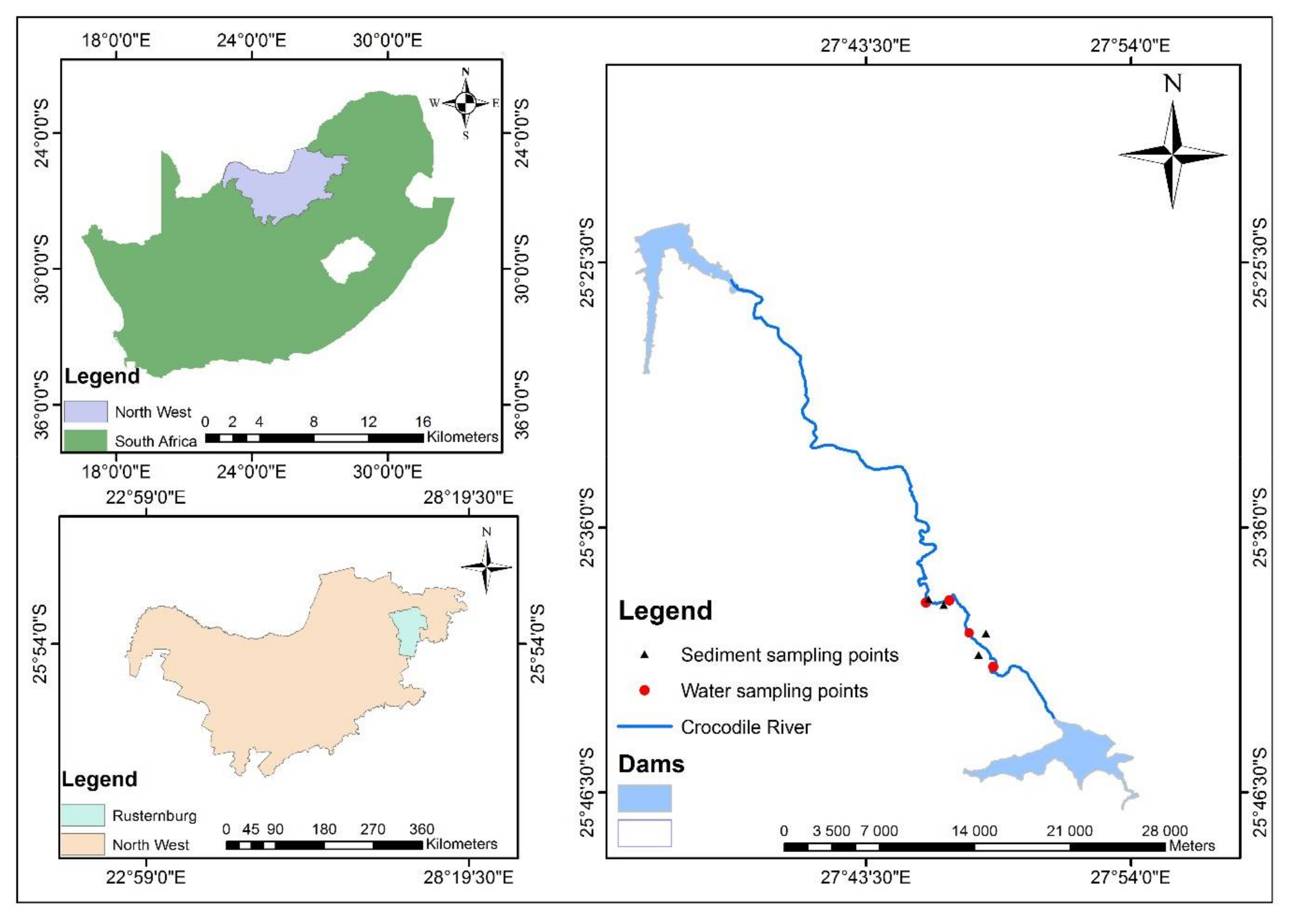1. Introduction
The quest for rapid economic growth through industrialisation has had a negative impact on receiving river systems [
1]. Anthropogenic activities like agriculture, mining and urbanization have been equally shown to have a negative impact in flowing rivers resulting in degradable aquatic ecosystems and habitats [
2]. Different studies have demonstrated that mining, industrial processing and agro-chemicals such as fertilizers and metal-based pesticides, which are toxic to human health, are the main sources of potential toxic element (PTE) concentrations in the environment [
3,
4,
5].
The presence these contaminants (copper (Cu), lead (Pb), cadmium (Cd), zinc (Zn), arsenic (As), chromium (Cr), aluminium (Al), manganese (Mn) and iron (Fe)) in water typically compromises the quality traits expected to be good for drinking, industrial processing and for biodiversity purposes. There is no doubt that South Africa, being a semi-arid country, is faced with a shortage of freshwater resources [
6]. Apart from naturally occurring metals in the environments, anthropogenic activities have equally accelerated the rate of toxic metal concentrations in freshwater over the last decades. This situation is being exacerbated by the continuous discharge of wastewater effluent from industrial plants, surface erosion from agricultural areas, mining and waste dumps from the population into nearby river bodies [
7,
8]. Surface contamination of sediments can act as a sink and secondary source of contamination [
9], since they can easily be adsorbed into sediment particles, transported as suspended sediment load, organic matter and nutrients [
10], thereby decreasing water quality [
11,
12], increasing turbidity, restricting light penetration and reducing primary production [
13].
Against this background of the national water crisis in South Africa, the Crocodile River in the North-west province, being a semi-arid region (Rustenburg), is no different from the other provinces with water-quality issues. The situation is being exacerbated by many industrial facilities, mining, agriculture as well as a dense population centre [
14] which is located not too far from the Crocodile River. Due to decades of intense mining and agriculture, this has had an unprecedented effect causing rapid deterioration of the quality of the river system. A report by the South African Department of Water Affairs and Forestry (DWAF) [
15] suggested that surface water in the Crocodile River catchment is being used extensively for agriculture, industry, mining and urban use. Agriculture activities are among the most important, second to platinum group mining in the area. According to van der Walt [
16], Impala Platinum produces more than 1.74 million ounces of platinum annually. Due to its rich mineral resources, there is an increased pressure on the natural environment in terms of large-scale industrialisation [
14]. However, a perusal of literature in the catchment suggest that baseline quantitative analysis of PTE contamination and sources have not been systematically reported to guarantee the health and safety of the population living in those areas.
Irrespective of their sources in the soil and water, the accumulation of PTEs can degrade soil and water quality [
17] when their toxicity levels are above the recommended threshold. According to Ongley et al. [
18], there are two types of non-point sources of contamination of particular concern for water quality: agriculture and urban non-point sources. A study by Miller et al. [
19] states that non-point sources of contamination are of particular concern in agricultural areas where sediment nutrients and pesticides may negatively impact water quality, as indicated in
Figure 1. Other studies have equally reported elevated levels of toxic elements concentrations in surrounding urban, mining and agricultural environments [
20,
21,
22]. Apart from river and soil contamination, the non-carcinogenic risk from exposure to some elements in local aquatic organisms and the riverine population need to be constantly measured to provide critical information about the environment [
22,
23,
24]. This is because once these toxic elements contaminate freshwater resources, they are likely to get into the food chain [
25,
26] thereby endangering human life. Hence, adequate monitoring of toxic elements has become an important priority over the last decades [
23].
A proper management system should be capable of distinguishing multiple sources of contamination within the catchment in order to make a clear distinction between various contributing areas. Although total metal concentration content in soil is useful to estimate the overall contamination potential, soil mobility does not necessarily depend directly on total metal content [
25]. Thus, a practical way is to identify the main sources of contamination from different land uses because a host of factors can impose changes on multiple sources of non-point sources under varying hydrological and land use conditions [
25,
27]. The determination of PTE levels in sediment and aquatic water is of primary concern for the environment besides the need to quantify their concentrations and spatial variability in soil and water. The objectives of this study are, therefore, to: (1) determine the spatial distribution of PTE concentration in water and soil across different land uses along the Crocodile River; (2) assess the degree of contamination in the catchment using indices of contamination. The results will improve our understanding of the possible risk of toxic metal content in the upper Crocodile River catchment, and this is among the few studies that have been conducted on sediment and water in river systems in the province.
4. Conclusions
This study concluded that the Crocodile River is contaminated with toxic elements, as Fe was found to be higher than is recommended by DWAF and USEPA. However, As, Cd, Cr, Cu, Pb and Zn were present in lower concentrations than the stipulated guideline values for aquatic life, but this does not exclude the fact that these values might eventually change in the future if they are considered over a continuous period of time due to the continuous discharge of contaminants into the river from privately owned resorts and accommodation and fertilizers from agricultural sites, as was observed during the field visit. This was confirmed, as the values of Cu and Pb were higher than the previously reported study in the catchment. The results of the metals analysis showed that the EF of Cr in the soil samples ranges in order of moderately to severe enrichment, revealing anthropogenic sources. This was supported by the CF ranging from moderately to high CF and Igeo also indicating moderately to highly contamination. In addition, the concentrations of Cr were above the ERL threshold limit in agriculture and urban land use, and the ERM threshold limit in resort/commercial and agriculture/mining land use of sediment quality guidelines for adverse biological effects, which may constitute an ecological risk as well as a risk to the population.
The positive correlations exhibited by the soil and water samples from the different land uses indicated that these elements are spatially distributed, having similar behaviour to a common source. Non-point sources of metals in the soil and river could possibly be attributed to anthropogenic activities such as agriculture, mining, resorts and privately owned accommodation, commercial activities and increasing population along the Crocodile River. A measure to curb metal pollution in the Crocodile River would be to avoid tannery discharge effluent into the river and farmland without prior treatment. Apart from the treatment of wastewater effluent discharge into the Crocodile River, it is imperative to adopt alternatives measures of cleaning up already existing contaminated substrates. Periodic monitoring of the soil and water rate of contamination and the consumption of fish from the river is, thus, necessary in order to assess the overall exposure level in the riverine communities, depending on the river.







